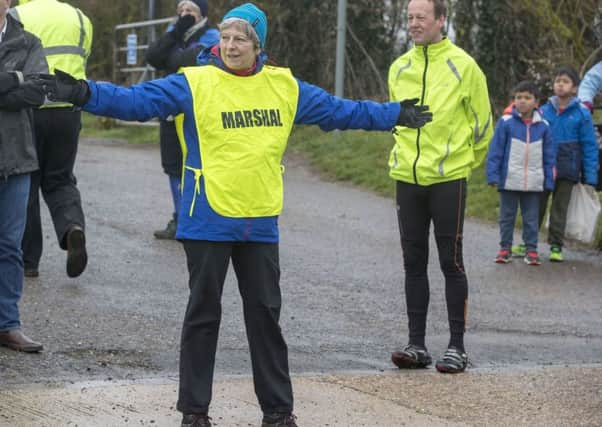Tom Richmond: Theresa May finds her stride and a new sense of direction


Arms stretched out, the Prime Minister appeared to be pointing bemused runners in both directions.
The picture is also emblematic of Mrs May’s character – the vicar’s daughter doing her duty in contrast to Labour leader Jeremy Corbyn’s lifetime of marching at demonstrations.
Advertisement
Hide AdAdvertisement
Hide AdYet, nearly a year after the Tory leader called an ill-advised general election, her premiership is reaching another turning point.
A PM who appeared fractious and ill-at-ease now appears more self-assured thanks, in no small part, to her leadership over the Russia spy poisoning scandal.
The leader recently described as “a dead woman walking” by George Osborne, the former Chancellor, seems revitalised.
There also appears to be more order to the chaos in Downing Street as the PM’s new aides tackle the disorder left behind by Fiona Hill and Nick Timothy.
Advertisement
Hide AdAdvertisement
Hide AdAnd Mrs May’s statesmanship contrasts with Mr Corbyn’s ineffectual response to the Russia crisis and waves of anti-Semitism allegations.
No wonder many of those voters who initially backed Mrs May, before deserting her at the ballot box last June, have renewed respect.
They don’t see a viable alternative with Brexit now less than a year away and want to entrust her to get on with the job.
Even the opinion polls show the Tories with a small lead at a time in the electoral cycle when the Opposition is normally surging clear as the ruling party becomes bogged down by the work of government.
Advertisement
Hide AdAdvertisement
Hide AdYet it was Labour that was staging rival rallies outside Parliament last month as the party’s MPs and activists opposed each other over anti-Semitism.
All this while Mrs May was completing the second phase of Brexit negotiations and persuading world leaders to back her over the expulsion of Russian diplomats.
The leader once shunned, and left isolated, by EU leaders is seen in a new light by Jean-Claude Juncker, Donald Tusk and others.
It helps. Britain is not leaving Europe on March 29 next year. It is exiting the EU and continued co-operation will be key on many issues, not least security.
Advertisement
Hide AdAdvertisement
Hide AdFurthermore, Britons admire a leader who is no push-over – David Cameron was punished when he asked for little and got even less in his EU re-negotiation.
However, while Tory strategists thought – wrongly – that last year’s election, would finish off Labour for a generation, there’s another realignment taking shape. Support for the Scottish National Party is flatlining, the Lib Dems are rapidly retreating to their core areas and Ukip appear to be finished.
Less than a decade after coalition governments appeared to be the new norm, traditional two-party politics appears, once again, to be pre-eminent.
And it is this subtle shift that provides Mrs May with opportunities – and challenges – if she’s to make the very most of her resurgence which, it still needs to be remembered, is never more than one knife-edge Commons vote away from coming to an abrupt end.
Advertisement
Hide AdAdvertisement
Hide AdContrary to public perception, record numbers of people are in employment. Yet, surprisingly, the Tories still seem shy to talk about the economy. They shouldn’t be. Just as New Labour focused on schools and hospitals to shift the political dial, Mrs May and her party need to do the same on jobs and security.
As recent announcements demonstrate, Ministers do need to highlight the link between Brexit, the economy and planned improvements to the NHS and other public services.
Yet, if support for Ukip, and the Lib Dems to a lesser extent, dissipates, the Tories can’t assume that supporters of these parties will switch to them.
After a decade of austerity over prosperity, Mrs May needs to improve her standing – and offering – to public sector workers, the low-waged and ‘just about managing’. These, and voters from ethnic minority backgrounds, need to be won over if the Conservatives are to be more confident of election success.
Advertisement
Hide AdAdvertisement
Hide AdAnd there’s also a lesson to be learned from Labour’s showing under Mr Corbyn.
He might be at odds with his MPs as the fragile post-election truce frays, but he still has a strong national following because of his connection with young voters, and also with the North, because of the work of Momentum activists.
Though some members hold repugnant views, Labour – unlike the Tories – is a mass membership party, and this explains, in part, why Theresa May lost her majority on June 8 last year.
In contrast to Mr Corbyn, she could not relate to the nurse in York who questioned her about the pay cap. And it is this bond that will be even more crucial if party politics becomes even more tribal – and focused on core domestic issues – once the Brexit deal is sealed.
Advertisement
Hide AdAdvertisement
Hide AdShe’s started to win back lost trust. She’s no longer regarded as the post-election figure of fun. She’s shown herself to be a serious stateswoman. She just needs to take her country in the right direction at this political crossroads and let her actions speak louder than Jeremy Corbyn’s words at every turn.